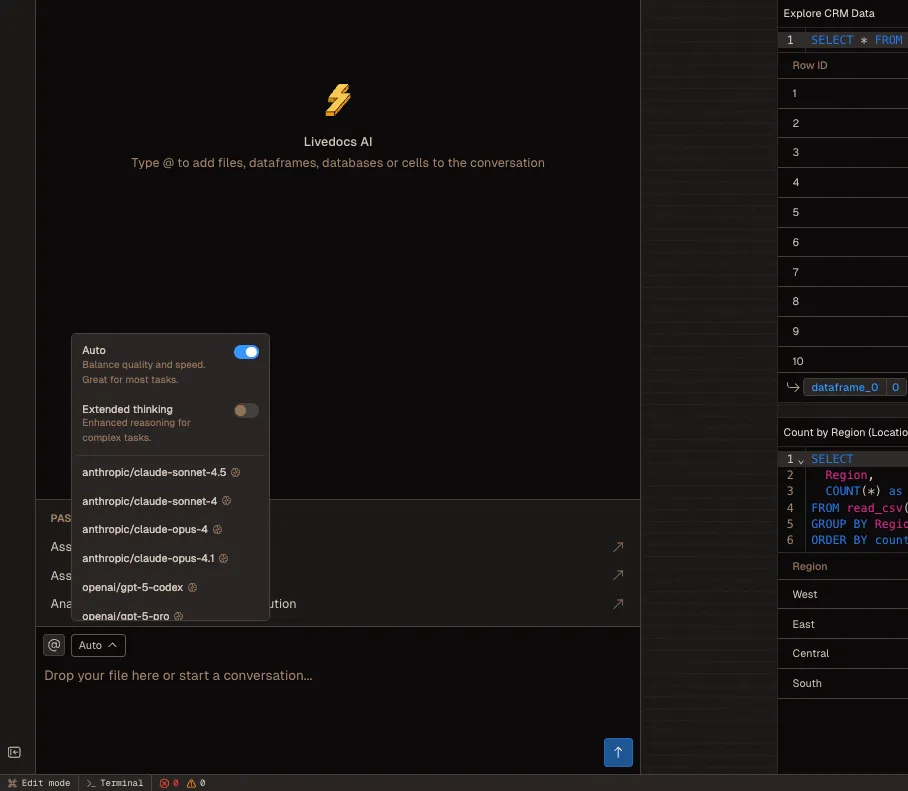How To Use Claude Sonnet For Data Cleaning
The “data-driven” dream often feels like a data-cleaning nightmare. You spend more time wrestling with spreadsheets than you do uncovering the insights hidden inside them.
That initial spark of a great idea gets drowned out by the tedious tasks of finding duplicates, standardizing formats, and fixing errors.
What if you could hand off the grunt work and jump straight to the good part?
The real goal was never to become the most hard working data scientist. It’s about finding the story the data is trying to tell.
It’s about making a confident decision. And now, with AI like Claude and powerful, agentic notebooks like Livedocs, you can finally automate the boring stuff and focus on what actually moves the needle.
The New Mindset: From Data Custodian to Data Director
Manually cleaning data isn’t just a time consuming; it’s a creativity killer. You get so bogged down in the minutiae that you lose the plot.
Automating this process does something profound: it preserves your mental energy for the high-value work that requires a human touch—asking “why,” connecting disparate ideas, and drawing meaningful conclusions.
Your Automation Toolkit: Claude as Your Data Apprentice
You don’t need a computer science degree to put Claude to work.
Its ability to understand natural language makes it an incredibly capable data apprentice. The process is more of a conversation than a coding session.
Imagine this:
-
You: “Claude, I’ve pasted our customer list. The ‘State’ column is a mess—some are abbreviations, some are full names. Please standardize everything to two-letter codes. Also, find any email addresses that don’t look valid.”
-
Claude: “I’ve standardized the state codes. I found 15 email addresses missing the ’@’ symbol, which I’ve flagged for you in a new column called ‘Needs Review’.”
It’s that straightforward. You provide the context and the command; Claude executes the logic. You remain the expert in the room, providing the final quality check.
Where Livedocs Changes the Entire Game: Your Agentic Notebook
Now, this is where the story gets interesting.
You can use Claude in a basic chat window, but that has not really utilised the power of AI for this case. To truly harness its power for data work, you need Livedocs.

Livedocs isn’t just another data platform. It’s an agentic notebook. What does that mean? It’s a workspace where you, your code, and an AI agent can work together interactively on a dataset.
Here’s the crucial part: while you can upload a single dataset directly to start, the real magic is that you can ask the Livedocs agent to go fetch any other datasets you need. This transforms a static analysis into a dynamic investigation.
So, what does this look like in practice?
-
You Build the Foundation. You start by building your own notebook in Livedocs. You might upload your core sales data.
-
Then, you instruct the built-in AI agent. Your prompt could be: “We have our sales data. Now, please fetch the latest regional economic indicators from [a public data source] and merge it with our dataset based on quarter and region.”
-
Inside that same Livedocs notebook, you can bring Claude into the mix. Once the agent has pulled in the new data, you can task Claude with the cleaning and transformation: “Claude, the economic data we just fetched has percentages stored as text. Please convert these to numerical values and create a new column that calculates our sales performance against the regional average.”
This creates a powerful, automated pipeline. You’re no longer just cleaning a single file; you’re orchestrating an entire data-gathering and preparation workflow.
Livedocs becomes your collaborative workspace, and the AI acts as your extendable hands, fetching and preparing data based on your strategic commands.
Here’s the crucial part: while you can upload a single dataset directly to start, the real magic is that you can ask the Livedocs agent to go fetch any other datasets you need. This transforms a static analysis into a dynamic investigation.
What to Do With All That Freedom
So, you’ve automated the fetch-and-clean cycle. The data is pristine and ready. What now? This is where you earn your salary.
Shift the time and brainpower you saved toward the work that actually matters:
-
Asking Deeper Questions: Instead of wondering if the dates are formatted correctly, you can ask, “What underlying customer behavior is causing this unexpected sales spike?”
-
Telling a Compelling Story: Use your clean, enriched data to build a narrative that resonates with your team. A clean chart is nice; a clear insight that leads to action is priceless.
-
Iterating at Speed: When data prep is no longer a week-long project, you can test a hypothesis, see the results, and pivot your strategy in a single afternoon.
Final Notes
Honestly, the goal was never to become the best data cleaner in the company.
The goal was to be the best strategist, the best innovator, the best problem-solver.
By combining Claude’s analytical prowess with the agentic, interactive environment of Livedocs, you’re not just streamlining a task—you’re fundamentally upgrading your role.
The best, fastest agentic notebook 2026? Livedocs.
- 8x speed response
- Ask agent to find datasets for you
- Set system rules for agent
- Collaborate
- And more
Get started with Livedocs and build your first live notebook in minutes.
- 💬 If you have questions or feedback, please email directly at a[at]livedocs[dot]com
- 📣 Take Livedocs for a spin over at livedocs.com/start. LinkedIn has a great free plan, with $10 per month of LLM usage on every plan
- 🤝 Say hello to the team on X and LinkedIn
Stay tuned for the next tutorial!

